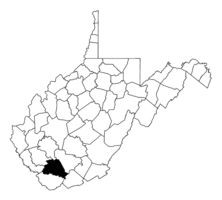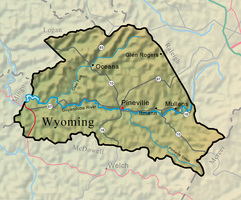
Wyoming County, with its rugged terrain bisected by the Guyandotte River, is located in the heart of West Virginia’s southern coal and natural gas producing region.
The county was formed by the Virginia General Assembly on January 26, 1850, from a part of Logan County. Only 6,247 residents were counted in the 1890 census, but the development of timbering, natural gas production, and coal mining pushed the population to 20,926 in 1930 and to a high of 37,540 in 1950. Like its neighbors, Wyoming County lost people with the loss of mining jobs. The population in 2020 was 21,382.
Wyoming County has a land area of 501.9 square miles. Oceana, established in 1797 by early settler and Revolutionary War veteran John Cooke, was the seat of government until the county seat was moved to Pineville when that town was incorporated in 1907. A handsome courthouse was built in 1916 of native stone from a local quarry.
Major timbering began in 1889. Logs were floated down the Guyandotte River to its junction with the Ohio River at Huntington. The Guyandotte River originates just over the border in neighboring Raleigh County, where Winding Gulf and Devils Fork creeks come together. The Guyandotte and its tributaries drain all of Wyoming County.
Completion of the Virginian Railway in 1909 sparked the area’s largest industrial boom by providing transportation of coal to ports on the Atlantic Ocean in Virginia. A large rail yard helped make Mullens the county’s largest incorporated town, with a population of 3,449 in 1950. Wyoming County ranked 10th statewide in coal production, with more than 566 million tons of coal extracted, for the period between 1883 and 1998. In 2021, Wyoming County produced 3.9 million tons of coal, ranking it seventh in West Virginia but had the fourth largest coal workforce (872).
Financier I. T. Mann and others developed a major coal company town and mine at Itmann, near Mullens, about 1916. Today Itmann’s massive cut-stone company store building remains a coalfields landmark. The first large mine was opened by Raleigh-Wyoming Coal Company at Glen Rogers in 1922 and employed nearly 1,000 men by the late 1930s. The mine was the scene of the county’s worst tragedy when an underground explosion on November 6, 1923, claimed 27 lives. A total of 160 workers were killed at the Glen Rogers mine during its 40 years of operation, making it one of the most dangerous work places in West Virginia’s history.
Developer C. H. Meade completed the first commercial natural gas well in 1919. The Ravencliff field, one of the state’s most productive gas fields, was named after a small community in the northeastern part of the county near Bolt Mountain.
As of 2022, the largest employers were, respectively, the county school system, Diversified Gas & Oil, Contura Energy, Mountainheart Community Services, and Trion Solutions.
In 1964, a Wyoming County petroglyph, located near Oceana, was recorded by archeologists Oscar Mairs and Hillis Youse. Named the Luther Elkins Petroglyph, it was studied again in 1969 when archeologist Sigfus Olafson documented the site. In 1982, the petroglyph attracted widespread attention when an amateur archeologist proclaimed it to be of Irish origin with ancient markings. The claim was generally dismissed by professional archeologists.
Chief among Wyoming County’s recreational facilities are Twin Falls Resort State Park, located between Pineville and Mullens, and R. D. Bailey Lake near Baileysville.
Prominent Wyoming County residents have included William C. Marland, who was elected governor in 1952; Robert D. Bailey, West Virginia secretary of state, 1965–68; Ward Wylie, a legislator and president of both the national boxing and wrestling associations in the late 1950s; and professional football star Curt Warner. Brothers Darrell V. and Warren R. McGraw both served on the West Virginia Supreme Court and in other high offices. Darrell McGraw was elected to the Supreme Court in 1977 and became state attorney general in 1993. Warren McGraw was elected to an unexpired term on the Supreme Court in 1998 and served through 2004. Warren McGraw also served in the House of Delegates from 1969 to 1972 before being elected to three terms in the state Senate. He was president of the Senate from 1981 to 1984.
This Article was written by Karl C. Lilly III
Last Revised on March 08, 2023
Related Articles
Sources
Bowman, Mary K. Reference Book of Wyoming County History. Parsons: McClain, 1965.
Perry, Bud & Karl C. Lilly III. Reopening Glen Rogers. Sissonville: PAL Productions.
"." National Register of Historic Places Nomination, Mullens Historic District, West Virginia Division of Culture & History, 1993.
West Virginia Blue Book. State of West Virginia. Charleston, 2000.
Cite This Article
Lilly III, Karl C. "Wyoming County." e-WV: The West Virginia Encyclopedia. 08 March 2023. Web. 27 July 2024.




Comments?
There aren't any comments for this article yet.
Click here to read and contribute to the discussion →